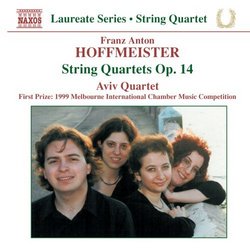| All Artists: Franz Anton Hoffmeister Title: Hoffmeister: String Quartets Op. 14 Members Wishing: 0 Total Copies: 0 Label: Naxos Original Release Date: 1/1/2003 Re-Release Date: 10/21/2003 Genre: Classical Styles: Chamber Music, Historical Periods, Classical (c.1770-1830) Number of Discs: 1 SwapaCD Credits: 1 UPCs: 747313595228, 747313595228 |
Search - Franz Anton Hoffmeister :: Hoffmeister: String Quartets Op. 14
CD Details |
CD ReviewsCharming and Well-Crafted Classical Era Quartets J Scott Morrison | Middlebury VT, USA | 12/19/2003 (4 out of 5 stars) "Franz Anton Hoffmeister (1754-1812), to the degree that he is remembered at all, is known from the 'Hoffmeister' string quartet Mozart named for him (No. 20 in D major, K. 499). And for a time a chamber music piece with flute by Hoffmeister was ascribed to Mozart and was played a lot in former times. He was also a music publisher and with a partner began the company that ultimately became the still important C. F. Peters company. Indeed, a letter to him from Mozart is the only one Mozart is known to have written to a publisher; in it he asks for money, and Hoffmeister recorded on the letter's envelope that he had responded by sending Mozart two ducats! Hoffmeister as a composer was in relation to Mozart much as Spohr or Hummel were to Beethoven. That is to say, he was a competent composer, maker of quite lovely pieces in the prevailing style but which lack that final spark of originality; yet they unfailingly fall pleasantly on the ear. On the evidence of the three quartets recorded here I hope to hear others of the more than thirty he completed. The first two of these three quartets from Hoffmeister's Op. 14 have only three movements. In the First, in F major, the high point is the gentle siciliano middle movement in rondo form; the recurring rondo theme is particularly ingratiating. A middle section mimics a sonata development. The third movement Allegro is also in rondo form and again there is a sonata-like middle section. It's as if Hoffmeister was working to master a form of his own devising. The Second quartet, in B flat, has a genial Allegro first movement with some fireworks for the first violin (shades of what Spohr did in his quartets a generation later!). The Romanza moves to G minor and has some serious overtones, but the somber tone is lightened by the gavotte rhythm. The finale is another rondo-allegro with some Haydnesque sforzandi. Although there are some feints in the direction of seriousness, it is generally quite playful.The Third quartet, in D minor, is in four movements and altogether more serious in tone than its siblings. The first movement is the weightiest (and longest) and has quite a sophisticated development section; in places its sense of drama reminds me of the first movement of Mozart's later 20th piano concerto in the same key. The following Adagio cantabile is a set of variations on a simple melody but it has some unexpected harmonic excursions and a dramatic outburst late in the movement with portentous rapid repeated notes in the accompaniment. The Minuet is a slightly harmonically unsettled minor-key movement that nonetheless hews to the usual form of the classic menuetto. In her excellent liner notes the Hoffmeister expert Dianne James comments that there are startling 'harmonic similarities between the first bars of the finale and the opening of the Minuet movement from Mozart's String Quartet in D, K. 499,' and boy is she right about that. It's kind of spooky, but then, as James points out, all becomes clear when one realizes that Hoffmeister had published the Mozart quartet in 1786, five years before his own Op. 14. Be that as it may, the Finale is gentle romp that brings the quartet, and the set, to a satisfying close.The performers here are the young Israeli quartet, the Aviv Quartet. The group was formed in 1997 and has won some competitions. They have a striking sense of ensemble, often seeming to breathe and bow as one. This is a quartet to watch. Naxos has provided exemplary warm sound with a sense of space around the quartet. One has come to expect, and usually get, this kind of attention to detail from their engineers.Scott Morrison"
|

